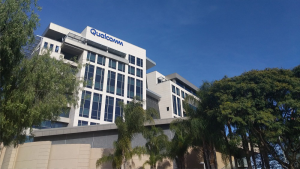The Shift to Smartphones in the Developed World
It’s a clear indication of mainstream smartphone adoption when even my mother is interested in getting a smartphone. She has always been content with a basic phone – not ![]() even a feature phone – but is now interested in getting a smartphone with mobile Internet connectivity. Just a year ago that she finally ditched the 768 Kbps basic DSL service to 6 Mbps (7 Mbps actual) AT&T U-verse service because she wanted a better experience with Netflix and YouTube, and now she wants mobile Internet goodness.
even a feature phone – but is now interested in getting a smartphone with mobile Internet connectivity. Just a year ago that she finally ditched the 768 Kbps basic DSL service to 6 Mbps (7 Mbps actual) AT&T U-verse service because she wanted a better experience with Netflix and YouTube, and now she wants mobile Internet goodness.
The holidays are upon us and people are probably looking for their first or second smartphone, so I’ve been inundated with questions from friends and family about which smartphone to get. Even people who already have their eyes set on an Apple iPhone now have questions because there are three major carriers offering Apple’s latest iPhone 4S. Others are asking me about what kind of non-Apple smartphone they should get. I’m going to try to summarize my advice below.
iPhone 4S
For iPhone 4S shoppers, the only decision they need to worry about is the color, flash memory storage capacity, and which carrier. While I’ve been happy with CDMA carriers like Verizon and have used Sprint in the past, I am very biased towards GSM carriers, which means AT&T. T-Mobile is also GSM but they don’t have the iPhone 4S so it’s irrelevant to this group of shoppers. LTE makes the issue of GSM versus CDMA moot because LTE uses SIM cards like GSM, but the iPhone 4S doesn’t have LTE so shoppers much pick a GSM or CDMA carrier.
The reason I prefer GSM is simple:
- When I travel abroad, most of the world uses GSM. I like swapping out SIM cards and having a local phone with local service rates.
- GSM allows concurrent voice and data services. If I’m on a phone call using speakers or a headset (bluetooth or wired), I like to be able to access the mobile Internet concurrently. This is possible in newer revisions of CDMA, but not for the iPhone 4S.
These two basic reasons tilt the decision towards AT&T for an iPhone 4S, but what sinks the deal in favor of an AT&T iPhone 4S is a recent report from Metrico showing that AT&T iPhone 4S runs averaged nearly 3 times faster than Verizon and 5.5 times faster than Sprint. Metrico performed 8000 speed tests so the results are fairly compelling. While Sprint might offer “unlimited” data for their iPhone 4S and call it “4G” data, it certainly doesn’t look like 4G based and it’s questionable as to whether they can avoid implementing some kind of data cap like every other major carrier.
What about cheap iPhones like the 3GS? Unless the buyer is absolutely adamant about having an Apple device and they can’t afford anything more than the iPhone 3GS, they can consider devices running Windows Phone 7 or 7.5. The iPhone 3GS runs at a relatively primitive “HVGA” 480×320 pixel resolution and it’s two generations behind. Windows Phone 7 devices are all 800×480 resolution and are often “free” with contract.
Android Smartphones
While Google Android and the devices running Android trailed far behind Apple iPhone, there is simply no denying that the most advanced and widest selection of smartphone hardware run Google Android today. Even fans of the Apple iPhone like my colleague Richard Bennett are “Giving Android a Chance“. More specifically, he had some irreconcilable issues with the iPhone 4S and he decided to give the Samsung Galaxy S II a chance.
The Galaxy S II (specifications) is probably the most popular Android smartphone on the market, and for good reason. The Galaxy is lighter and thinner than the iPhone 4S, yet it has a big and beautiful 4.3″ AMOLED display that is much larger than the iPhone 4S’ 3.5″ display. Even though the resolution on the iPhone 4S (960×640 pixels) is better than the Galaxy S II (800×600 pixels), most people prefer larger displays, even if they have perfect vision. And for playback standardized widescreen video content like TV shows, movies, and the gorgeous 1080P videos you can record on either the Galaxy S II or the iPhone 4S, the Galaxy S II widescreen display can play movies back with 1.8 times the viewing size.
For the really advanced customers who are willing to pay a premium price, they could try something like the Samsung Galaxy Nexus (specifications) which has even higher resolution (1280×720 pixels) than the iPhone 4S (960×640 pixels), and its massive 4.65″ display can render widescreen video 2.1 times bigger than the iPhone 4S. Despite the massive display size, Samsung managed to build the device thinner and lighter than the iPhone 4S. Apple shocked the world with its revolutionary iPhone in 2007, but the iPhone seems a a little less revolutionary these days compared with its Android based competitors.
What about budget smartphone buyers? I would give the same advice to budget iPhone buyers, which is to be aware that the lower end devices are very slow and only support lower 480×320 resolution which is difficult and unpleasant to read web pages on. Look to the low cost or even “free” (with contract) Windows Mobile 7 or 7.5 smartphones which all run 800×480 resolution and have much nicer cameras.
Microsoft Smartphones
For really affordable and simple to use smartphones, Microsoft Windows Phone 7.5 devices like the HTC Radar (my review here) fits the bill with its solid aluminum body. The HTC Radar is mainstream smartphone with modest features but holiday discounts might drive the price closer to free with contract from T-Mobile. While the HTC Radar is about as boring as a sedan compared to the Android based hot-rods like the Galaxy S II, not everyone is looking or willing to pay for a hot-rod.
For people looking for a better Windows Phone 7 experience, the HTC Titan (specifications) with its massive 4.7 inch display offers a reasonably priced solution. The HTC Titan is no where close to a Samsung Galaxy Nexus because its slightly thicker, only supports 720P video capture, and has a modest 800×480 pixel display, the Titan isn’t outrageously priced like the Galaxy Nexus.
Conclusion
The market for smartphones is extremely mature and more competitive than other with three robust platforms and “app” markets. For developed nations, the cost of smartphones have come down so far that they aren’t much more expensive than “feature phones” yet they do so much more. Just the camera and GPS with traffic mapping functionality of smartphones make them compelling enough that even low-tech consumers are attracted to the devices.
[Cross-posted at High Tech Forum]
A message from John Furrier, co-founder of SiliconANGLE:
Your vote of support is important to us and it helps us keep the content FREE.
One click below supports our mission to provide free, deep, and relevant content.
Join our community on YouTube
Join the community that includes more than 15,000 #CubeAlumni experts, including Amazon.com CEO Andy Jassy, Dell Technologies founder and CEO Michael Dell, Intel CEO Pat Gelsinger, and many more luminaries and experts.
THANK YOU













